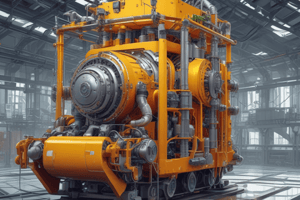Podcast
Questions and Answers
Match the following types of plastic with their characteristics:
Match the following types of plastic with their characteristics:
Thermoplastics = Melt and are deformable Thermosets = Have a rigid structure and cannot be melted again Elastomers = Softened at room temperature and elastic Amorphous plastics = Disordered and often transparent
Match the following polymerization reactions with their descriptions:
Match the following polymerization reactions with their descriptions:
Polycondensation = Brings together 2 different or identical substances Polyaddition = Does not create any byproducts
Match the following plastic types with some examples:
Match the following plastic types with some examples:
Semi-crystalline plastics = PP, PE-HD, PE-LD Amorphous plastics = ABS, PS-HI, PVC Thermosets = Bakelite, Melamine formaldehyde Elastomers = Rubber
Match the following terms with their related concepts:
Match the following terms with their related concepts:
Match the following properties with their corresponding plastic types:
Match the following properties with their corresponding plastic types:
Match the following characteristics with their types of polymerization:
Match the following characteristics with their types of polymerization:
Match the following types of plastics with their processing characteristics:
Match the following types of plastics with their processing characteristics:
Match the classifications of plastics with their descriptions:
Match the classifications of plastics with their descriptions:
Flashcards
Polycondensation
Polycondensation
A chemical reaction where two or more monomers join together to form a polymer, releasing a small molecule like water as a byproduct.
Polyaddition
Polyaddition
A chemical reaction that joins monomers to form a polymer without releasing any byproducts. The atoms in the monomers rearrange to create the polymer.
Thermoplastics
Thermoplastics
A type of plastic that can be repeatedly melted and reshaped without breaking down. They form long chains that can be easily rearranged by heating.
Amorphous Thermoplastics
Amorphous Thermoplastics
Signup and view all the flashcards
Semicrystalline Thermoplastics
Semicrystalline Thermoplastics
Signup and view all the flashcards
Thermosets
Thermosets
Signup and view all the flashcards
Elastomers
Elastomers
Signup and view all the flashcards
Intermolecular Bonds
Intermolecular Bonds
Signup and view all the flashcards
Study Notes
Plastics Composition
- Plastics are composed of carbon-hydrogen bonds.
- Monomers combine to form polymers.
- Two main polymerization reactions are polycondensation and polyaddition.
Polycondensation
- Combines two or more different or identical substances.
- Creates water as a byproduct, which must be removed.
- Examples include polyester, polyether, and polyamide.
Polyaddition
- Combines two identical or different substances.
- Rearranges atomic order compared to monomers.
- Requires a catalyst and high temperature/pressure.
- Doesn't produce any byproducts.
Types of Plastics
- Classified into thermoplastics, elastomers, and thermosets.
Thermoplastics
- Melt when heated.
- Covalent bonds are resistant to temperature changes.
- Intermolecular forces (e.g., hydrogen bonds) weaken at higher temperatures.
- Can be easily reshaped.
- Two types: Amorphous and Semicrystalline
- Amorphous: Disordered structure, glassy, transparent, brittle.
- Semicrystalline: Partially ordered, crystalline regions with ductile loops, opaque, better thermal resistance.
- Examples: Polypropylene (PP), High-density polyethylene (PE-HD), Low-density polyethylene (PE-LD), and Linear Low-density polyethylene (PE-LLD), and others.
Elastomers
- Soft or rubbery at room temperature.
- 2D or 3D network structure with large meshes and connections between chains.
- Can be stretched and return to original shape (elastic).
- Examples include Ethylene-propylene-diene-monomer (EPDM),.
Thermosets
- 3D network structure with strong bonds between chains.
- Rigid structure.
- Cannot be melted or reshaped after curing (often a chemical reaction during hardening).
- Cannot be reused or reformed after the initial molding.
- Examples include bakelite, melamine formaldehyde.
Studying That Suits You
Use AI to generate personalized quizzes and flashcards to suit your learning preferences.




